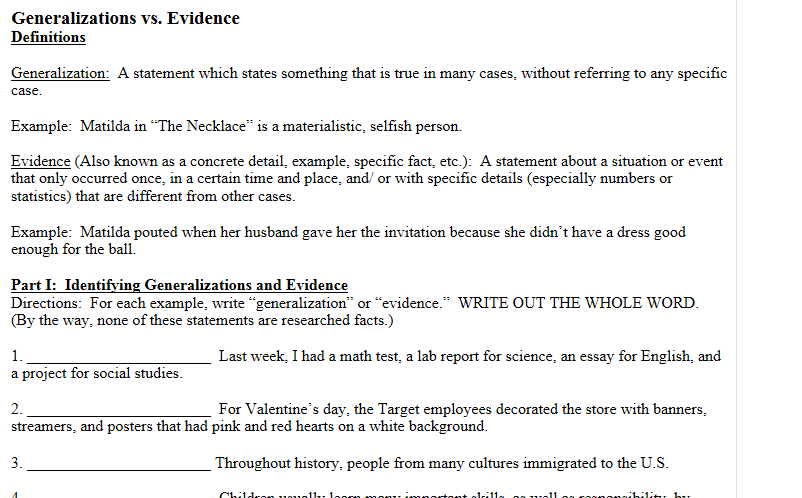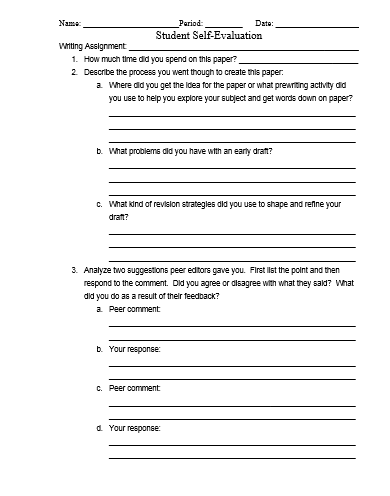Day 1: Describe a challenge you have faced that has impacted your character.
Day 2: Who has most inspired/impacted your life? Please explain.
Day 3: What is the most important value in life? Please explain.
I collect the writes each day and use them for a couple of different purposes: 1) to give the kids feedback on which one they wrote the best on 2) to provide me with data about what I need to teach/focus on during the unit. I treat these almost as a pre-write. These pre-writes are also helpful for the students. Most students do really well on one and feel like they were pressed for time to get done, while they struggle on a different one. This helps them to narrow down the prompt that is right for them. They also have already done an outline and thesis and have the brainstorming for their essay done. This makes the whole assignment much less daunting and intimidating. Rather than writing from scratch, they are writing from a draft.
The first day of instruction is focused around the thesis statement.
We start with notes on three different types of statements: the power/number statement (a statement involving a word like "three", "many", "various", etc.), the list statement (a simple list of the three topics to be covered) and a semi-colon statement (this just involves using a semi-colon to replace a conjunction in a statement - notice I snuck some grammar instruction in there).
Next, we look closely at each prompt and we pick out the "buzz" words in the prompt: the main/key/most important words. We create a word bank for these words with phrases/synonyms that mean the same thing (notice my embedded vocabulary instruction here).
Finally, I model examples of each type of thesis statement for each of the prompts. Students then determine a prompt to write thesis statements for. They write on only one prompt today. They write only a thesis statement, but three different types. I take their statements home and give them feedback.
The next day we do peer edits for the statements: the students look for the synonyms/similar phrases, a direct answer to one of the prompts, and conventions. I usually talk about some violations of grammar rules that I noticed when reviewing the previous night and have the students check for these in particular. The students revise their thesis statements and pick just one to develop for their essay.
Here is the edit I created for this:
Every other bit of instruction revolves around this thesis statement. We start with the introduction paragraph. I talk about how to use an anecdote for an effective hook and how to use a quote for an effective hook. I model this for each prompt and the students write two hooks for their thesis = one of each type. Next, we talk about what would be appropriate background information for each prompt. I model, the students apply. We peer edit. We revise.
Here is the peer edit that I created for the introduction paragraph this year. I try to tailor the grammar/convention portions of the edit specifically to struggles that I have witnessed recently within the writing of my students. We review those rules with examples and then they look closely for these violations - I have found this to be much more helpful than just asking them to edit (in general) for spelling, punctuation, etc.
Next, I ask my students to create an outline (theirs is electronic) - I model one for each of the different prompts. I ask them to look back at their in-class writes to generate ideas for subtopics. Here is my example outline(s) for each prompt option:
The next day students are expected have a completed outline with them in class. We use these outlines to begin work on our body paragraphs.
We follow the same basic format for topic sentences - a full day for these - with a focus on transitions (I provide a cheat-sheet - see below - for these) and referencing the thesis.
Then we move on to evidence and commentary. We look extensively on the difference between evidence and commentary and how to identify each one and write each type as well. I usually have them write body paragraph 1 after this, so that they can write while it is fresh in their minds. Here is the start of that activity:
We also review the difference between specific evidence and a generalization. Then, they write body paragraph 2. Here is the start of that activity:
Here is one example of a model done in class:
Finally, we review, model, write, edit and revise the conclusion paragraph. Here is my edit for the conclusion paragraph:
MLA format is required at my school so we spend a day applying this to our papers.
Now, the students start to publish their work using Word.
After the students have an entire draft typed, we do a couple of writer's workshop days where they are able to pick from many different editing/revising strategies that we have used during the unit and apply those to their writing. We generally do this for two days. The first half of day one they do one of the editing options, the second half they revise. The first half of day two, they do a different option and then revise.
The night before their essay is do, I try to get their parent/guardian involved, by having a very focused community member edit. I send the kids home with an edit sheet that they bring back the next day attached to their FINAL essay.
I like to end an essay unit with reflection.
I end this unit by collecting data. I collect and analyze data from the performance of my students. I use that data to inform my instruction is subsequent writing units with these students.














No comments:
Post a Comment